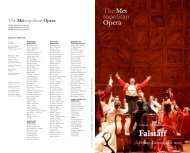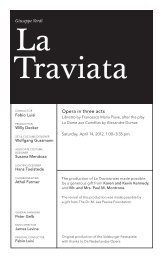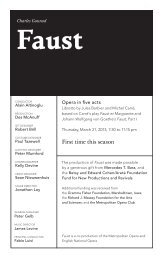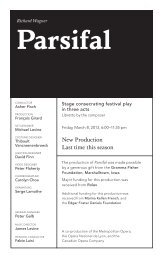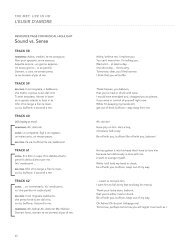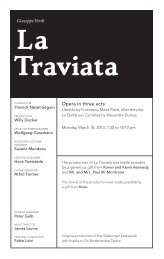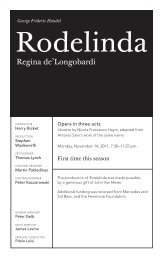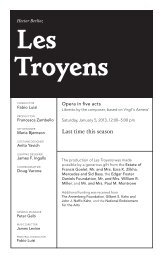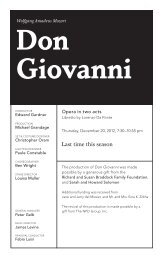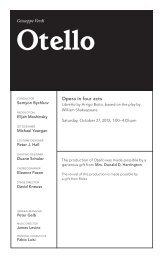The Magic Flute - Metropolitan Opera
The Magic Flute - Metropolitan Opera
The Magic Flute - Metropolitan Opera
You also want an ePaper? Increase the reach of your titles
YUMPU automatically turns print PDFs into web optimized ePapers that Google loves.
Wolfgang Amadeus Mozart<br />
<strong>The</strong><br />
<strong>Magic</strong> <strong>Flute</strong><br />
CONDUCTOR<br />
Jane Glover<br />
PRODUCTION<br />
Julie Taymor<br />
Libretto by Emanuel Schikaneder<br />
Monday, December 30, 2013, 11:00–12:40<br />
SET DESIGNER<br />
George Tsypin<br />
COSTUME DESIGNER<br />
Julie Taymor<br />
LIGHTING DESIGNER<br />
Donald Holder<br />
PUPPET DESIGNERS<br />
Julie Taymor<br />
Michael Curry<br />
CHOREOGRAPHER<br />
Mark Dendy<br />
STAGE DIRECTOR<br />
David Kneuss<br />
ENGLISH ADAPTATION<br />
J. D. McClatchy<br />
GENERAL MANAGER<br />
Peter Gelb<br />
MUSIC DIRECTOR<br />
James Levine<br />
PRINCIPAL CONDUCTOR<br />
Fabio Luisi<br />
This abridged production of<br />
<strong>The</strong> <strong>Magic</strong> <strong>Flute</strong> was made possible by<br />
a gift from <strong>The</strong> Andrew W. Mellon Foundation,<br />
and Bill Rollnick and Nancy Ellison Rollnick.<br />
<strong>The</strong> original production of Die Zauberflöte<br />
was made possible by a gift from<br />
Mr. and Mrs. Henry R. Kravis.<br />
Additional funding was received from John Van Meter,<br />
<strong>The</strong> Annenberg Foundation, Karen and Kevin Kennedy,<br />
Bill Rollnick and Nancy Ellison Rollnick, Mr. and Mrs.<br />
William R. Miller, Agnes Varis and Karl Leichtman,<br />
and Mr. and Mrs. Ezra K. Zilkha.<br />
Maestro Glover’s performances with the<br />
<strong>Metropolitan</strong> <strong>Opera</strong> this season are dedicated<br />
to the memory of Dr. Agnes Varis, who<br />
championed women conductors.
2013–14 Season<br />
<strong>The</strong> 414th <strong>Metropolitan</strong> <strong>Opera</strong> performance of<br />
Wolfgang Amadeus Mozart’s<br />
<strong>The</strong> <strong>Magic</strong> <strong>Flute</strong><br />
Conductor<br />
Jane Glover<br />
in order of vocal appearance<br />
Tamino<br />
Alek Shrader<br />
First Lady<br />
Wendy Bryn Harmer*<br />
Second Lady<br />
Renée Tatum*<br />
Third Lady<br />
Margaret Lattimore*<br />
Papageno<br />
Nathan Gunn*<br />
Queen of the Night<br />
Kathryn Lewek<br />
First Slave<br />
Stephen Paynter<br />
Second Slave<br />
Kurt Phinney<br />
Third Slave<br />
Craig Montgomery<br />
Monostatos<br />
John Easterlin<br />
Pamina<br />
Heidi Stober<br />
First Spirit<br />
Connor Tsui<br />
Second Spirit<br />
Seth Ewing-Crystal<br />
Third Spirit<br />
Andre Gulick<br />
Speaker<br />
Shenyang*<br />
Sarastro<br />
Eric Owens<br />
First Priest<br />
Paul Corona<br />
Second Priest<br />
Scott Scully<br />
Papagena<br />
Ashley Emerson*<br />
First Guard<br />
Anthony Kalil**<br />
Second Guard<br />
Jordan Bisch*<br />
solo dancer<br />
Rachel Schuette<br />
flute solo<br />
Denis Bouriakov<br />
Monday, December 30, 2013, 11:00–12:40
KEN HOWARD/METROPOLITAN OPERA<br />
Nathan Gunn<br />
as Papageno in<br />
Mozart’s <strong>The</strong><br />
<strong>Magic</strong> <strong>Flute</strong><br />
* Graduate of the<br />
Lindemann Young Artist<br />
Development Program<br />
** Member of the<br />
Lindemann Young Artist<br />
Development Program<br />
Yamaha. Celebrating 25 Years<br />
as the Official Piano<br />
of the <strong>Metropolitan</strong> <strong>Opera</strong>.<br />
Latecomers will not be<br />
admitted during the<br />
performance.<br />
Visit metopera.org<br />
Chorus Master Donald Palumbo<br />
Musical Preparation Gregory Buchalter, Bradley Moore,<br />
Liora Maurer, and Steven White<br />
Assistant Stage Director J. Knighten Smit<br />
Prompter Gregory Buchalter<br />
Met Titles Michael Panayos<br />
Children’s Chorus Director Anthony Piccolo<br />
English Coach Erie Mills<br />
Projection Designer Caterina Bertolotto<br />
Makeup Designer Reiko Kruk<br />
Associate Set Designer Iosef Yusupov<br />
Associate Costume Designer Mary Peterson<br />
Puppets constructed by Michael Curry Design, Inc.<br />
and <strong>Metropolitan</strong> <strong>Opera</strong> Shops<br />
Scenery, properties, and electrical props constructed<br />
and painted in <strong>Metropolitan</strong> <strong>Opera</strong> Shops<br />
Costumes executed by <strong>Metropolitan</strong> <strong>Opera</strong><br />
Costume Department<br />
Wigs and Makeup executed by <strong>Metropolitan</strong> <strong>Opera</strong> Wig<br />
and Makeup Department<br />
This performance is made possible in part by public funds<br />
from the New York State Council on the Arts.<br />
Before the performance begins, please switch off cell phones<br />
and other electronic devices.<br />
This production uses lightning effects.<br />
Met Titles<br />
To activate, press the red button to the right of the screen in front of<br />
your seat and follow the instructions provided. To turn off the display,<br />
press the red button once again. If you have questions please ask an<br />
usher at intermission.
LEE BROOMFIELD / METROPOLITAN OPERA<br />
2013–14 season<br />
Mariusz Kwiecien and Anna Netrebko<br />
in Eugene Onegin<br />
<strong>The</strong> <strong>Metropolitan</strong> <strong>Opera</strong> is pleased<br />
to salute Yamaha in recognition<br />
of its generous support<br />
during the 2013–14 season.<br />
Celebrating 25 years as the<br />
official piano of the <strong>Metropolitan</strong> <strong>Opera</strong>
An Illustrated Synopsis for<br />
<strong>The</strong> <strong>Magic</strong> <strong>Flute</strong><br />
1<br />
Performed without intermission<br />
A mythical land between the sun and the moon. Three ladies in the service<br />
of the Queen of the Night save Prince Tamino from a serpent. When they<br />
leave to tell the queen, the birdcatcher Papageno appears (1). He boasts<br />
to Tamino that it was he who killed the creature. <strong>The</strong> ladies return to give<br />
Tamino a portrait of the queen’s daughter, Pamina, who they say has been<br />
enslaved by the evil Sarastro. Tamino immediately falls in love with the<br />
(above) <strong>The</strong> birdcatcher Papageno explains that he is given food and drink by<br />
the Queen of the Night in return for his birds.<br />
Visit metopera.org<br />
39
2<br />
<strong>The</strong> Queen of the Night appears,<br />
grieving over the loss of her<br />
daughter.<br />
3<br />
(above) As Pamina sleeps,<br />
Monostatos is startled by the<br />
unexpected arrival of Papageno.<br />
girl’s picture. <strong>The</strong> queen, appearing<br />
in a burst of thunder (2), tells<br />
Tamino about the loss of her<br />
daughter and commands him to<br />
rescue her. <strong>The</strong> ladies give a magic<br />
flute to Tamino and silver bells to<br />
Papageno to ensure their safety<br />
on the journey and appoint three<br />
spirits to guide them.<br />
Sarastro’s slave Monostatos<br />
pursues Pamina but is frightened<br />
away by Papageno (3). <strong>The</strong><br />
birdcatcher tells Pamina that<br />
Tamino loves her and is on his way<br />
to save her. Led by the three spirits<br />
to the temple of Sarastro, Tamino<br />
learns from a high priest that it is<br />
the Queen, not Sarastro, who is<br />
evil. Hearing that Pamina is safe,<br />
Tamino charms the wild animals<br />
with his flute (4), then rushes off<br />
to follow the sound of Papageno’s<br />
pipes. Monostatos and his men<br />
(below) Tamino hopes the charmed<br />
animals will lead him to Pamina.<br />
4<br />
40
5<br />
chase Papageno and Pamina but<br />
are left helpless when Papageno<br />
plays his magic bells (5). Sarastro<br />
enters in great ceremony (6). He<br />
punishes Monostatos and promises<br />
Pamina that he will eventually set<br />
her free. Pamina catches a glimpse<br />
of Tamino, who is led into the<br />
temple with Papageno.<br />
(above) <strong>The</strong> magic bells save<br />
Pamina and Papageno from<br />
Monostatos’s men.<br />
(below) Sarastro arrives at<br />
his temple of wisdom.<br />
6<br />
7<br />
Pamina contemplates the dagger her<br />
mother gave her when she ordered<br />
her to murder Sarastro.<br />
Sarastro tells the priests that<br />
Tamino will undergo initiation<br />
rites. Monostatos tries to kiss the<br />
sleeping Pamina but is surprised<br />
by the appearance of the Queen<br />
of the Night. <strong>The</strong> Queen gives her<br />
daughter a dagger and orders her<br />
to murder Sarastro (7).<br />
Visit metopera.org<br />
41
8<br />
Papageno promises not to eat,<br />
but quickly fails the test.<br />
<strong>The</strong> Three Spirits lead Tamino<br />
to his next trial.<br />
9<br />
Sarastro finds the desperate Pamina<br />
and consoles her, explaining that<br />
he is not interested in vengeance.<br />
Tamino and Papageno are told by a<br />
priest that they must remain silent<br />
and are not allowed to eat (8), a<br />
vow that Papageno immediately<br />
breaks when he takes a glass of<br />
water from a flirtatious old lady.<br />
When he asks her name, she<br />
vanishes. <strong>The</strong> three spirits guide<br />
Tamino through the rest of his<br />
journey (9) and tell Papageno to<br />
be quiet. Tamino remains silent<br />
even when Pamina appears.<br />
Misunderstanding his action for<br />
coldness, she is heartbroken.<br />
<strong>The</strong> priests inform Tamino that<br />
he has only two more trials to<br />
complete his initiation. Papageno,<br />
who has given up on entering<br />
the brotherhood, longs for a wife<br />
instead. He eventually settles for<br />
the old lady. When he promises<br />
to be faithful she is suddenly<br />
transformed into a beautiful young<br />
42
10<br />
Papagena, then immediately<br />
disappears (10).<br />
Pamina and Tamino are reunited<br />
and face the ordeals of water and<br />
fire together, protected by the<br />
magic flute.<br />
Papageno pleads for a cute and<br />
cuddly wife but an old lady<br />
arrives instead.<br />
Sarastro, Pamina, and Tamino<br />
celebrate when the Queen of the<br />
Night and her allies are defeated.<br />
Desperate to be without a wife,<br />
Papageno tries to hang himself on<br />
a tree but is saved by the three<br />
spirits, who remind him that if he<br />
uses his magic bells he will find true<br />
happiness. When he plays the bells,<br />
Papagena appears and the two<br />
immediately start making family<br />
plans. <strong>The</strong> Queen of the Night,<br />
her three ladies, and Monostatos<br />
attack the temple but are defeated<br />
and banished. Sarastro blesses<br />
Pamina and Tamino as all join in<br />
hailing the triumph of courage,<br />
virtue, and wisdom (11).<br />
11<br />
Photos: 2 & 8, Cory Weaver/Met <strong>Opera</strong>; 9, Beatriz Schiller/Met <strong>Opera</strong>; all others by Ken Howard/Met <strong>Opera</strong><br />
Visit metopera.org<br />
43
In Focus<br />
Wolfgang Amadeus Mozart<br />
<strong>The</strong> <strong>Magic</strong> <strong>Flute</strong><br />
Premiere: Freihaus-<strong>The</strong>ater auf der Wieden, Vienna, 1791<br />
<strong>The</strong> <strong>Magic</strong> <strong>Flute</strong> is the Met’s abridged English-language version of Mozart’s<br />
Die Zauberflöte, a sublime fairy tale that moves freely between earthy comedy<br />
and noble mysticism. Mozart wrote the original opera, in German, for a theater<br />
located just outside Vienna with the clear intention of appealing to audiences<br />
from all walks of life. <strong>The</strong> story is told in a Singspiel (“song-play”) format<br />
characterized by separate musical numbers connected by dialogue and busy<br />
action, an excellent structure for navigating the diverse moods, which range<br />
from solemn to lighthearted, of the story and score. <strong>The</strong> composer and the<br />
librettist were both Freemasons—the fraternal order whose membership is held<br />
together by shared moral and metaphysical ideals—and Masonic imagery is<br />
used throughout the work. <strong>The</strong> story, however, is as universal as any fairy tale.<br />
<strong>The</strong> Creators<br />
<strong>The</strong> music of Wolfgang Amadeus Mozart (1756–1791) continues to enthrall<br />
audiences around the world, and his achievements in opera, in terms of<br />
beauty, vocal challenges, and dramatic insight, remain unsurpassed. He died<br />
prematurely, three months after the premiere of Die Zauberflöte. It was his last<br />
produced work for the stage. (<strong>The</strong> court opera La Clemenza di Tito had its<br />
premiere three weeks before Die Zauberflöte, though its score was completed<br />
later.) <strong>The</strong> remarkable Emanuel Schikaneder (1751–1812) was an actor, singer,<br />
theater manager, and friend of Mozart. He suggested the idea of Die Zauberflöte,<br />
wrote the libretto, staged the work, and sang the role of Papageno in the initial<br />
run. After Mozart’s death, Schikaneder opened the larger <strong>The</strong>ater an der Wien<br />
in the center of Vienna, a venue that has played a key role in the city’s musical<br />
life from the time of Beethoven to the present day. <strong>The</strong> former main door of<br />
the theater is called the “Papageno Gate,” a tribute to both men. <strong>The</strong> English<br />
translation for the Met’s abridged version of <strong>The</strong> <strong>Magic</strong> <strong>Flute</strong> is by American<br />
poet and librettist J. D. McClatchy.<br />
<strong>The</strong> Setting<br />
<strong>The</strong> libretto specifies Egypt as the location of the action. That country was<br />
traditionally regarded as the legendary birthplace of the Masonic fraternity,<br />
whose symbols and rituals populate this opera. Some productions include<br />
Egyptian motifs as an exotic nod to this idea, but most opt for a more generalized<br />
44
mythic ambience to convey the otherworldliness that the score and overall tone<br />
of the work call for.<br />
<strong>The</strong> Music<br />
Die Zauberflöte was written with an eye toward a popular audience, but the<br />
varied tone of the work requires singers who can specialize in several different<br />
musical genres. <strong>The</strong> comic and earthy is represented by the baritone Papageno<br />
in his delightful arias “I’m Papageno” and “A Cuddly Wife or Sweetheart,” with<br />
its jovial glockenspiel accompaniment. Papageno meets his comic match in the<br />
“Bird-Girl” Papagena and their funny (but rather tricky) duet “Pa-pa-pa-pa.” True<br />
love in its noblest forms is conveyed by the tenor Tamino (in his ravishing aria<br />
“This Portrait’s Beauty”) and the soprano Pamina (in the deceptively transparent<br />
“Now My Heart Is Filled with Sadness”). <strong>The</strong> bass Sarastro expresses the solemn<br />
and the transcendental in his noble “Within Our Sacred Temple.” <strong>The</strong> Three<br />
Ladies have much ensemble work of complex beauty, and even the short<br />
scene for the Three Spirits singing to the sunrise has a unique aura of hushed<br />
beauty well beyond the conventions of standard popular entertainment of the<br />
time. <strong>The</strong> use of the chorus is spare but hauntingly beautiful. <strong>The</strong> fireworks are<br />
provided by the coloratura Queen of the Night with her first aria, “My Fate is<br />
Grief,” scarcely less pyrotechnic than the more familiar “Hell’s Bitterness.”<br />
<strong>The</strong> <strong>Magic</strong> <strong>Flute</strong> at the Met<br />
<strong>The</strong> Met has a remarkable history of distinguished productions of Die<br />
Zauberflöte with extraordinary casts. <strong>The</strong> opera was first given here in 1900<br />
in Italian and featured Emma Eames, Andreas Dippel, and Pol Plançon. In<br />
1941 a new production in English featured Jarmila Novotná, Charles Kullman,<br />
Alexander Kipnis, Friedrich Schorr, and a young Eleanor Steber as the First Lady.<br />
It was conducted by Bruno Walter, directed by Herbert Graf, and designed<br />
by Richard Rychtarik. <strong>The</strong> legendary 1967 production, with designs by Marc<br />
Chagall, featured Josef Krips conducting Pilar Lorengar, Nicolai Gedda, Lucia<br />
Popp, Hermann Prey, Morley Meredith, Rosalind Elias, and Jerome Hines.<br />
<strong>The</strong> Mozart anniversary year of 1991 saw the debut of a ravishing production<br />
designed by David Hockney and directed by John Cox and Guus Mostart, with<br />
James Levine conducting Kathleen Battle, Francisco Araiza, Luciana Serra, Kurt<br />
Moll, and Wolfgang Brendel. <strong>The</strong> present production by Julie Taymor, with sets<br />
designed by George Tsypin, costumes by Taymor, and choreography by Mark<br />
Dendy, opened in 2004 with James Levine conducting a cast that included<br />
Dorothea Röschmann, Matthew Polenzani, L’ubica Vargicová, Rodion Pogossov,<br />
and Kwangchul Youn.<br />
Visit metopera.org<br />
45
A Note from the Translator<br />
46<br />
Ideally, a translation of an opera should be tailored to fit the production. If<br />
a director wants Tamino in a powdered wig and frock coat enacting an<br />
allegory of Masonic beliefs, that would suggest one kind of translation. If,<br />
on the other hand, the director sets the opera in Disneyland, with Tamino in<br />
jeans and an iPod for his magic flute, a very different verbal style would be<br />
called for. Fortunately, for this enchanting Met production, Julie Taymor (and<br />
I can’t help but think this is exactly what Mozart and Schikaneder would have<br />
wanted) chose the timeless world of the fairy tale, with its deliberate mix of<br />
high romance and low comedy, of mystery and mayhem. My task was to dress<br />
it in an English that fits.<br />
To be avoided at all costs was the usual opera-ese (“Wilt thou to the palace<br />
with me now go, most valiant prince?”), which can often make opera-in-English<br />
sound stranger than in the original language. After all, the style of a translation<br />
affects how an audience understands and sympathizes with—or not—the<br />
characters on stage. Stiff diction and forced rhymes can make a character seem<br />
wooden and remote and thereby distort important emotional balances in the<br />
structure of the opera.<br />
Of course, it is not an “opera” one is translating, but a combination of very<br />
distinct voices, a set of different characters each with his or her own personality<br />
concocted of words and music. Tamino’s ardent nobility can at one moment be<br />
vulnerable, at another courageous. Pamina’s emotions are more complex and<br />
have a maturity forced on her by tortuous circumstances. Sarastro’s paternal<br />
steadiness, the Queen of the Night’s grieving hysteria, and Monostatos’s oily<br />
conniving are starkly different. And Papageno’s inimitable range of humorous<br />
earthiness yields readily to a kind of “bird-language” all his own.<br />
<strong>The</strong> style of <strong>The</strong> <strong>Magic</strong> <strong>Flute</strong>—a singspiel that intersperses arias and<br />
ensembles with scenes of spoken dialogue—gave us another opportunity.<br />
For our abridged version (it should be remembered that this opera has been<br />
variously shortened and re-arranged in performance for over 200 years), I<br />
have wanted both to follow the libretto and to clarify it. This opera’s plot has<br />
sometimes confused its critics into complaining of inconsistencies, but the<br />
word magic is not in its title by accident. As in a dream, an inner logic threads<br />
together sudden changes of course or motivation, as the fates of three pairs—<br />
Tamino and Pamina, Papageno and Papagena, Sarastro and the Queen of the<br />
Night—are slowly entwined and transformed. Still, what in the original can seem<br />
arcane or convoluted, I have tried to pose as the elemental struggle between<br />
the forces of darkness and light, reason and chaos, and as the triumph of love<br />
over adversity and isolation. Papageno finds the maiden beneath the crone, and<br />
Tamino finds his love through trial and patience. Each discovers the world is<br />
different than it seemed at first. I suppose that, in the end, you might even say<br />
this is an opera about translation.<br />
—J. D. McClatchy
<strong>The</strong> Cast<br />
Jane Glover<br />
conductor (london, england)<br />
this season <strong>The</strong> <strong>Magic</strong> <strong>Flute</strong> with <strong>Opera</strong> <strong>The</strong>atre of St. Louis and for her debut at the Met,<br />
Lucio Silla in Bordeaux, her debut with the Cleveland Orchestra conducting Beethoven’s<br />
Piano Concerto No. 1, and conducting assignments with the Mark Morris Dance Group.<br />
career highlights She is music director of Chicago’s Music of the Baroque and artistic<br />
director of <strong>Opera</strong> at London’s Royal Academy of Music, and made her professional debut<br />
in 1975 conducting her own edition of Cavalli’s L’Eritrea at the Wexford Festival. Known<br />
primarily as a Mozart specialist, she has conducted all the composer’s operas regularly all<br />
over the world with notable performances including the Da Ponte trilogy in Chicago, Die<br />
Entführung aus dem Serail at Covent Garden, and Così fan tutte in Berlin. Her core repertory<br />
also includes works by Monteverdi, Handel, and Britten, among others. Highlights of<br />
recent seasons include <strong>The</strong> Turn of the Screw and Jephtha in Bordeaux, Gluck’s Armide for<br />
a joint production of the Met and the Juilliard School, Don Giovanni in St. Louis, Semele in<br />
Milwaukee, La Clemenza di Tito and Die Zauberflöte for Chicago <strong>Opera</strong> <strong>The</strong>atre, and <strong>The</strong><br />
Rape of Lucretia, A Midsummer Night’s Dream, and L’Incoronazione di Poppea in Aspen.<br />
Kathryn Lewek<br />
soprano (east lyme, connecticut)<br />
this season <strong>The</strong> Queen of the Night in <strong>The</strong> <strong>Magic</strong> <strong>Flute</strong> with Lyric <strong>Opera</strong> of Kansas<br />
City and for debuts at the Met and Washington National <strong>Opera</strong>, the Fairy in Massenet’s<br />
Cendrillon with New Orleans <strong>Opera</strong>, and Angelica in Handel’s Orlando in Tasmania with<br />
Hobart Baroque.<br />
career highlights She was a double prize winner of Plácido Domingo’s 2013 <strong>Opera</strong>lia<br />
World <strong>Opera</strong> Competition and recently sang the Queen of the Night with English<br />
National <strong>Opera</strong>, Nashville <strong>Opera</strong>, in Leipzig, and at the Bregenz Festival. She has also<br />
sung a number of roles with the Deutsche Oper Berlin including the Queen of the Night,<br />
Frasquita in Carmen, the Sandman and Dew Fairy in Hansel and Gretel, Barbarina in Le<br />
Nozze di Figaro, and Pisana in I Due Foscari. She has also sung with Berlin’s Deutsches<br />
Symphonie-Orchester, Toledo Symphony, Rochester Philharmonic, Santa Barbara<br />
Symphony, and at Carnegie Hall with Musica Sacra.<br />
Visit metopera.org<br />
47
<strong>The</strong> Cast CONTINUED<br />
Heidi Stober<br />
soprano (waukesha, wisconsin)<br />
this season Pamina in <strong>The</strong> <strong>Magic</strong> <strong>Flute</strong> at the Met, Nannetta in Falstaff and Magnolia in<br />
Jerome Kern’s Show Boat at the San Francisco <strong>Opera</strong>, and Susanna in Le Nozze di Figaro<br />
and Pamina at the Deutsche Oper Berlin.<br />
met appearances Gretel in Hansel and Gretel (debut, 2011).<br />
career highlights She has been a member of the Deutsche Oper Berlin since 2008 where<br />
she has sung a number of roles including Micaëla in Carmen, Oscar in Un Ballo in Maschera,<br />
Princess Ninette in Prokofiev’s L’Amour des Trois Oranges, Nannetta, and Gretel. Recent<br />
performances include Ada in the world premiere of Morrison’s Oscar with the Santa Fe<br />
<strong>Opera</strong> and Musetta in La Bohème at Houston Grand <strong>Opera</strong>. Additional performances<br />
include Atalanta in Handel’s Serse and Sophie in Werther with the San Francisco <strong>Opera</strong>,<br />
Aminta in Mozart’s Il Re Pastore with <strong>Opera</strong> <strong>The</strong>atre of St. Louis, and Atalanta, Susanna,<br />
Blondchen in Die Entführung aus dem Serail, Drusilla in L’Incoronazione di Poppea, and<br />
Norina in Don Pasquale with the Houston Grand <strong>Opera</strong>.<br />
Nathan Gunn<br />
baritone (south bend, indiana)<br />
this season Papageno in <strong>The</strong> <strong>Magic</strong> <strong>Flute</strong> at the Met, James Dalton in the world premiere<br />
of Iain Bell’s A Harlot’s Progress at Vienna’s <strong>The</strong>ater an der Wien, Figaro in Il Barbiere di<br />
Siviglia at the Dallas <strong>Opera</strong> and Lyric <strong>Opera</strong> of Chicago, and Gaylord Ravenal in Jerome<br />
Kern’s Show Boat with the San Francisco <strong>Opera</strong>.<br />
met appearances Over 100 performances of 14 roles, including the title role of Billy<br />
Budd, Raimbaud in Le Comte Ory, Clyde Griffiths in the world premiere of Picker’s An<br />
American Tragedy, Guglielmo in Così fan tutte, Demetrius in A Midsummer Night’s Dream,<br />
Schaunard in La Bohème, and in the ensemble of <strong>The</strong> Ghosts of Versailles (debut, 1995).<br />
career highlights He created a number of roles in world premieres, including Yeshua<br />
in Mark Adamo’s <strong>The</strong> Gospel of Mary Magdalene for the San Francisco <strong>Opera</strong>, Alec<br />
Harvey in Previn’s Brief Encounter at the Houston Grand <strong>Opera</strong>, Father Delura in Peter<br />
Eötvös’s Love and Other Demons at Glyndebourne, and Paul in Daron Hagen’s Amelia at<br />
the Seattle <strong>Opera</strong>. He is a graduate of the Met’s Lindemann Young Artist Development<br />
Program and in 2006 was the first recipient of the Met’s Beverly Sills Artist Award.<br />
48
Eric Owens<br />
bass-baritone (philadelphia, pennsylvania)<br />
this season Sarastro in <strong>The</strong> <strong>Magic</strong> <strong>Flute</strong> at the Met, Vodník in Rusalka at Lyric <strong>Opera</strong><br />
of Chicago, the title role of Handel’s Hercules with the Canadian <strong>Opera</strong> Company, and<br />
Alberich in Wagner’s Ring cycle at the Deutsche Oper Berlin and Vienna State <strong>Opera</strong>.<br />
met appearances General Leslie Groves in Doctor Atomic (debut, 2008) and Alberich.<br />
career highlights Recent performances include Capellio in Bellini’s I Capuleti e i Montecchi<br />
with the San Francisco <strong>Opera</strong> and Sharpless in Madama Butterfly at the Los Angeles <strong>Opera</strong>.<br />
He has also sung General Leslie Groves with the San Francisco <strong>Opera</strong> (world premiere)<br />
and Lyric <strong>Opera</strong> of Chicago, Oroveso in Norma at Covent Garden and in Philadelphia,<br />
Fiesco in Simon Boccanegra and Porgy in Porgy and Bess with Washington National<br />
<strong>Opera</strong>, Ramfis in Aida in Houston and San Francisco, the Speaker in Die Zauberflöte with<br />
Paris’s Bastille <strong>Opera</strong>, Rodolfo in La Sonnambula in Bordeaux, Ferrando in Il Trovatore<br />
and Colline in La Bohème in Los Angeles, and Hercules with the Lyric <strong>Opera</strong> of Chicago.<br />
Shenyang<br />
bass-baritone (tianjin, china)<br />
this season <strong>The</strong> Speaker in <strong>The</strong> <strong>Magic</strong> <strong>Flute</strong> at the Met and concert appearances with the<br />
New York Philharmonic, Philadelphia Orchestra, San Francisco Symphony, and Huangzhou<br />
Philharmonic.<br />
met appearances Garibaldo in Rodelinda, Masetto in Don Giovanni (debut, 2009), and<br />
Colline in La Bohème.<br />
career highlights Recent performances include Figaro in Le Nozze di Figaro in<br />
Beijing, Alidoro in La Cenerentola for his debut at the Glyndebourne Festival, Osmin<br />
in a concert performance of Mozart’s Zaïde at Carnegie Hall with Ensemble ACJW, and<br />
concert engagements with the Toronto Symphony Orchestra, Shanghai Symphony<br />
Orchestra, Boston Symphony Orchestra, Hong Kong Philharmonic, Dallas Symphony<br />
Orchestra, and Cincinnati Symphony Orchestra. He has also sung Brahms’s Liebeslieder<br />
at Carnegie Hall with the MET Chamber Ensemble, was a winner of the 2007 BBC Cardiff<br />
Singer of the World Competition, and is a graduate of the Met’s Lindemann Young Artist<br />
Development Program.<br />
Visit metopera.org<br />
49
<strong>The</strong> Cast CONTINUED<br />
Alek Shrader<br />
tenor (cleveland, ohio)<br />
this season Tamino in <strong>The</strong> <strong>Magic</strong> <strong>Flute</strong> at the Met and in concert with the Los Angeles<br />
Philharmonic, Ernesto in Don Pasquale at the Santa Fe <strong>Opera</strong>, and Count Almaviva in Il<br />
Barbiere di Siviglia at the San Francisco <strong>Opera</strong>, Lyric <strong>Opera</strong> of Chicago, and Dallas <strong>Opera</strong>.<br />
met appearances Ferdinand in <strong>The</strong> Tempest (debut, 2012) and Count Almaviva in <strong>The</strong><br />
Barber of Seville.<br />
career highlights Recent performances include Don Ramiro in La Cenerentola in<br />
Hamburg, Ernesto in Don Pasquale at the Glyndebourne Festival, Tom Rakewell in <strong>The</strong><br />
Rake’s Progress in Lille, Tamino with Lyric <strong>Opera</strong> of Chicago and San Francisco <strong>Opera</strong>,<br />
the title role of Britten’s Albert Herring with the Los Angeles <strong>Opera</strong> and Santa Fe <strong>Opera</strong>,<br />
Oronte in Handel’s Alcina in Bordeaux, and Gonzalve in Ravel’s L’Heure Espagnole at the<br />
Glyndebourne Festival. He has also sung the title role of Bernstein’s Candide in concert<br />
with the Los Angeles Orchestra, Egeo in Giovanni Simon Mayr’s Medea in Corinto with<br />
Munich’s Bavarian State <strong>Opera</strong>, and Ferrando in Così fan tutte at the Salzburg Festival. He<br />
was a 2007 winner of the Met’s National Council Auditon.<br />
50



